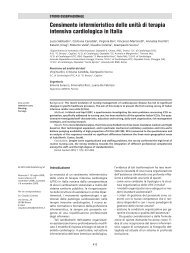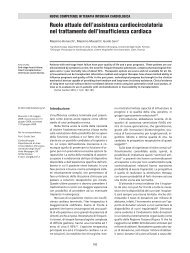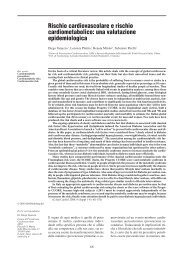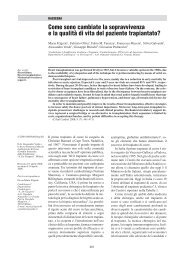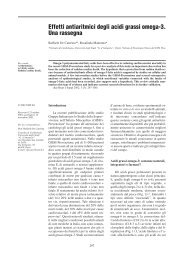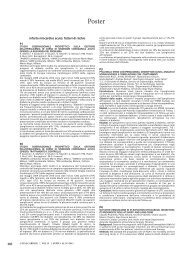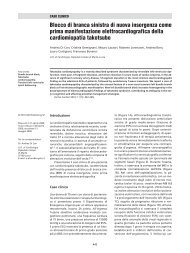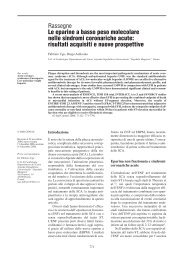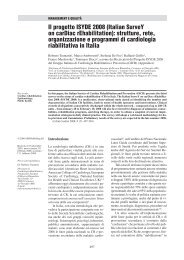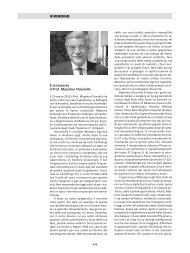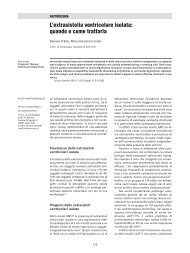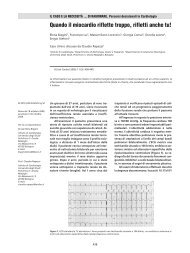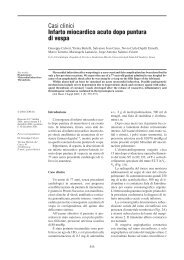COMUNICAZIONI - Giornale Italiano di Cardiologia
COMUNICAZIONI - Giornale Italiano di Cardiologia
COMUNICAZIONI - Giornale Italiano di Cardiologia
Create successful ePaper yourself
Turn your PDF publications into a flip-book with our unique Google optimized e-Paper software.
G Ital Car<strong>di</strong>ol Vol 8 Suppl 2-5 2007<br />
Results. Successful deployment of the stent grafts in the intended position was<br />
achieved in 44 patients (98%). Twenty-two patients received a single stent graft,<br />
16 patients had 2 and one patient received 4 stents. There was one hospital<br />
death.<br />
A single primary <strong>di</strong>slocation required surgical transposition of the aortic arch<br />
branches and the positioning of a second stent. Four surgical procedures have<br />
been performed to facilitate the endovascular approach: three transpositions of<br />
the aortic arch branches, and one carotid-subclavian shunt.<br />
Complications included permanent paraplegia in 2 patients and transitory<br />
paraplegia requiring spinal fluid drainage in one patient. Type I endoleaks were<br />
reported in 4 patients and were successfully repaired by using endovascular<br />
techniques.<br />
No peripheral embolization or <strong>di</strong>stal migration of the stents were observed. No<br />
surgical conversion of the procedure was needed at the time of stent graft<br />
placement and at follow up. There were 5 late deaths (two procedure-related).<br />
Conclusions. In our experience endovascular stent-graft repair of <strong>di</strong>fferent types<br />
of descen<strong>di</strong>ng thoracic aortic <strong>di</strong>seases is a less invasive procedure alternative to<br />
surgical repair with acceptable morbi<strong>di</strong>ty and mortality rate. A team approach<br />
between interventional ra<strong>di</strong>ologists and surgeons and careful follow-up of the<br />
patient is mandatory to manage complications and to optimize the treatment of<br />
complex lesions involving the thoracic aorta.<br />
C66<br />
SAFETY AND EFFICACY OF PROTECTED CAROTID ARTERY STENTING IN<br />
ELDERLY PATIENTS - A SINGLE CENTER EXPERIENCE<br />
A. Rizza, C. Palmieri, G. Trianni, L. Sulcaj, A. Al-Jabri, M. Ravani, M. Vaghetti,<br />
S. Berti<br />
Institute of Clinical Physiology-CNR, “G. Pasquinucci” Hospital, Massa, Italy<br />
Background. Stroke is the second cause of death in elderly patients and 30-60%<br />
of strokes in this age group are due to carotid stenosis. Carotid angioplasty with<br />
stenting (CAS) is an alternative to endarterectomy for treatment of carotid<br />
stenosis. Little is known about the results of CAS in elderly patients.<br />
Objective. To assess the early- and long-term results of protected CAS in elderly<br />
patients.<br />
Methods. Included in this study were 70 patients aged >75 years with carotid<br />
stenosis who underwent CAS with embolic protection devices in our hospital. Of<br />
the whole population 53 patients had a history of coronary artery <strong>di</strong>sease and 37<br />
of them had undergone revascularization procedures; 18 patients suffered<br />
peripheral artery <strong>di</strong>sease; and 1 patient had renal artery stenosis. Mean age of<br />
patients included in the study was 79±4 years; 24 patients were women. The<br />
following risk factors: <strong>di</strong>abetes mellitus type II, arterial hypertension, and<br />
hypercholesterolemia, were present in 27%, 90%, and 84% of the patients,<br />
respectively. Of the total study population, 30 patients had bilateral carotid-artery<br />
<strong>di</strong>sease and 12 patients had suffered prior ischemic events. The following types<br />
of carotid stents were implanted: Acculink (66 patients), Precise (3 patients) and<br />
Wallstent (1 patients). The following types of embolic protection devices were<br />
used: Accunet (54 patients), Percusurge (5 patients), Mo.Ma (8 patients) and<br />
PAES (3 patients). Postprocedural antiplatelet therapy consisted of aspirin and a<br />
thienopyri<strong>di</strong>ne agent during the first month and beyond it, all patients received<br />
aspirin indefinitely. Clinical follow-up after hospital <strong>di</strong>scharge was performed by<br />
visits at the outpatient clinic after 25±13 months following the index procedure.<br />
Results. In the early periprocedural period only 1 study patient suffered stroke;<br />
no other adverse events occurred during this period of time. Mean hospitalization<br />
time was 3±1 days, except for the single patient who developed stroke. At a mean<br />
follow-up period of 25 months, 1 patient had a transient ischemic attack while 3<br />
patients developed restenosis. No patients <strong>di</strong>ed or suffered a myocar<strong>di</strong>al<br />
infarction during the follow-up period.<br />
Conclusions. The results of this study demonstrate that CAS with embolic<br />
protection device can be safely and effectively performed in elderly patients with<br />
significant carotid artery <strong>di</strong>sease.<br />
C67<br />
TRATTAMENTO DELLE STENOSI CAROTIDEE CON IMPIANTO DI STENT:<br />
FOLLOW-UP CLINICO-STRUMENTALE A 1, 2 e 3 ANNI<br />
S. Galli, P. Montorsi, S. Ghulam-Ali, P. Ravagnani, F. Fabbiocchi, A. Lual<strong>di</strong>,<br />
D. Trabattoni, S. De Martini, G. Calligaris, G. Teruzzi, L. Grancini, A.L. Bartorelli<br />
Centro Car<strong>di</strong>ologico Monzino, IRCCS, Università <strong>di</strong> Milano, Italia<br />
Introduzione e scopo. Il trattamento delle stenosi carotidee con impianto <strong>di</strong> stent<br />
(CAS) risulta ormai un’alternativa alla tra<strong>di</strong>zionale endoarterectomia (TEA).<br />
Tuttavia se i risultati a breve termine risultano sovrapponibili, poco è noto in<br />
merito a quelli relativi all’outcome dei pz. trattati con CAS. Scopo dello stu<strong>di</strong>o è<br />
valutare i risultati a me<strong>di</strong>o e a lungo termine <strong>di</strong> CAS.<br />
Meto<strong>di</strong>. Dal 2003 278 pz. consecutivi (età me<strong>di</strong>a 71.3±7.5 aa) sono stati<br />
sottoposti a CAS, tutti con condotte con protezione cerebrale, prevalentemente<br />
con filtri (Filtri 95%; Sistemi Occlusivi 5%). Gli stent utilizzati con design de<strong>di</strong>cato<br />
erano: Wallstent 35%; Précise 25%; Protegé 20%; X-ACT 17% ed altri 3%. I pz.,<br />
se sintomatici con stenosi ≥50% e asintomatici ≥75%), venivano sottoposti a<br />
valutazione clinico-neurologica e strumentale con TC encefalo basale ed ECOdoppler<br />
basale, a 3-6 mesi, a 12 mesi e quin<strong>di</strong> a cadenza annuale.<br />
Risultati. Sesso maschile 65%; <strong>di</strong>abete mellito 21% e ad elevato rischio<br />
chirurgico nel 22% dei casi. Sintomatici erano il 35% con stenosi ECOdoppler<br />
basale = 85±7%. La morfologia della stenosi era: soft/ulcerata 28%; fibrosa 40%;<br />
calcifica 25% e ristenosi post-TEA 7%. Nel 68% dei casi è stato eseguito impianto<br />
<strong>di</strong>retto con post-<strong>di</strong>latazione nel 99% dei casi. Il filtro presentava debris nel 60%<br />
dei casi. Il tempo procedurale è risultato pari a 18±7 min. Il successo procedurale<br />
è stato raggiunto nel 98% mentre quello angiografico nel 99% dei casi. Le<br />
complicanze minori sono state: TIA 17 (6.1%; 11 risolti in sala angiografica e 6 in<br />
reparto); ipotensione ortostatica >24 ore 11 (4%) e 6 (2.1%) le complicanze<br />
vascolari maggiori in sede <strong>di</strong> accesso femorale. Gli eventi avversi maggiori sono<br />
rappresentati in tabella:<br />
FU a 30 gg A 1 anno A 2 anni A 3 anni Totale<br />
N=278(%) N=208(%) N=137(%) N=75(%) N=278(%)<br />
Morte Totale 0 (0) 4 (1.9) 0 (0) 0 (0) 0 (0)<br />
Morte cerebro-car<strong>di</strong>ovascolare 0 (0) 1 (0.5) 0 (0) 0 (0) 0 (0)<br />
Morte non-car<strong>di</strong>aca 0 (0) 3 (1.4) 0 (0) 0 (0) 0 (0)<br />
Stroke Maggiore Ipsilaterale 2 (0.7) 0 (0) 0 (0) 0 (0) 2 (0.7)<br />
Stroke Minore Ipsilaterale 2 (0.7) 2 (0.9) 0 (0) 0 (0) 4 (1.4)<br />
IMA Q/non-Q 0 (0) 5 (2.4) 3 (4.5) 2 (2.6) 10 (3.6)<br />
Stroke Maggiore Controlaterale 0 (0) 0 (0) 0 (0) 1 (1.3) 1 (0.3)<br />
Stroke Minore Controlaterale 0 (0) 0 (0) 0 (0) 0 (0) 0 (0)<br />
MACCE Composito 4 (1.4) 11 (5.3) 7 (5.1) 7 (9.3) 24 (8.6)<br />
Sopravv. libera da eventi 274 (98.6) 197 (94.7) 130 (94.9) 68 (90.6) 254 (91.3)<br />
Ristenosi all’ECO ≥50% 0 (0) 2# (0.9) 0 (0) 0 (0) 2 (0.7)<br />
MACCE: eventi avversi maggiori cerebro-car<strong>di</strong>ovascolari (Morte, Stroke Maggiore e Minore e IMA<br />
Q/nonQ). #2 pz. con PSV= 150 cm/sec, stenosi derivata >50%, asintomatici, non trattate.<br />
Conclusioni. I risultati, <strong>di</strong> questo stu<strong>di</strong>o monocentrico e prospettico, confermano<br />
che il trattamento delle stenosi carotidee con CAS risulta altamente efficace e<br />
sicuro. Anche i risultati clinico-strumentali a me<strong>di</strong>o-lungo termine confermano che<br />
tale efficacia e sicurezza si mantengono nel tempo.<br />
Car<strong>di</strong>ochirurgia<br />
C68<br />
IS THERE STILL A ROLE OF PNEUMATIC ASSIST DEVICES FOR<br />
MECHANICAL CIRCULATORY SUPPORT IN THE CURRENT ERA? THE<br />
UDINE EXPERIENCE<br />
G. Guzzi, V. Tursi, E. Spagna, L.P. Badano, D. Pavoni, E. Auci, A. Morelli, U. Livi<br />
Department of Car<strong>di</strong>opulmonary Sciences, S. Maria della Misericor<strong>di</strong>a<br />
University-General Hospital, U<strong>di</strong>ne<br />
Objectives. In recent years, new types of mechanical assist devices are<br />
available, so the use of pneumatic ventricular assist devices (p-VAD) is<br />
decreasing in favour of smaller pumps, considered to be more handy and less<br />
invasive. Aim of the study is to evaluate our experience in using p-VAD, mainly as<br />
bridge-to-transplant (BTT) and bridge-to-recovery (BTR).<br />
Methods. Between 1994 and 2006, 22 pts were assisted with a p-VAD (Berlin<br />
Heart Excor ® ) as BTT (18 pts, group A), BTR (3 pts, group B) or as postcar<strong>di</strong>otomy<br />
assistance (1 pt).<br />
All pts were male, mean age 49±14 years (range 14-67 years); in<strong>di</strong>cations for<br />
assistance were ischemic or <strong>di</strong>lated car<strong>di</strong>omyopathy in most of cases bridged to<br />
HTx, acute myocar<strong>di</strong>tis in recovered pts. In all but three patients assistance was<br />
biventricular (BVAD), the remaining being left ventricular (LVAD).<br />
Anticoagulation protocol consisted of a combination of acetylsalicylic acid and<br />
warfarin (or acenocumarole) accor<strong>di</strong>ng to INR (target range 3.0-3.5); no i.v.<br />
heparin needed.<br />
Results. Overall mean (me<strong>di</strong>an) time of assistance (TA) was 31(22)±34 days<br />
(range 1-146 years).<br />
In group A, 13 pts were transplanted after a mean (me<strong>di</strong>an) TA of 32(26)±17 days<br />
(range 6-68 days) and 10 of them are long-term survivors; in group B, weaning<br />
from assistance occurred after 14(15)±2 days (range 12-16 days). The only pt<br />
assisted after surgical closure of a wide ventricular septal defect post-AMI <strong>di</strong>ed<br />
after one day.<br />
Assistance succeeded in improving hemodynamics and organ functions, above<br />
all hepatic and renal; in BTR cases, car<strong>di</strong>ac function was fully recovered.<br />
No neurologic events occurred, being blee<strong>di</strong>ng the most frequent complication<br />
(overall 36%).<br />
Overall early patient survival was 60%; in group A, early survival of transplanted<br />
pts was 77%, in group B 100%.<br />
Conclusions. Mechanical circulatory support with p-VADs, both in case of BTT<br />
and BTR, demonstrates to be reliable and safe in our experience; clinical results<br />
are satisfactory and similar to those of most recent pumps, still supporting their<br />
use in such cases.<br />
C69<br />
DISFUNZIONE DIASTOLICA NEI PAZIENTI CON POSTUMI DI INTERVENTO<br />
DI RIVASCOLARIZZAZIONE MIOCARDICA: IMPLICAZIONI PROGNOSTICHE<br />
A. Lerro, F. Petteruti, A. Luciano, G. De Luca, G. Coronella, A. Contaldo,<br />
P. Oliviero, P. Pepino<br />
Dipartimento <strong>di</strong> Chirurgia Car<strong>di</strong>otoracica Clinica Pineta Grande, Castel Volturno<br />
(CE)<br />
Premessa. Le mo<strong>di</strong>fiche delle proprietà <strong>di</strong>astoliche del ventricolo sinistro (VS)<br />
possono essere stu<strong>di</strong>ate attraverso le registrazioni doppler del flusso mitralico e<br />
le misurazioni delle velocità <strong>di</strong> flusso e degli intervalli <strong>di</strong> tempo. Le loro variazioni<br />
si verificano in relazione alle anologhe variazioni delle pressioni atriali e<br />
ventricolari e sono globalmente definite come <strong>di</strong>sfunzione <strong>di</strong>astolica (DD).<br />
Scopo. Valutare le alterazioni della funzione <strong>di</strong>astolica nei pazienti sottoposti ad<br />
intervento car<strong>di</strong>ochirurgico <strong>di</strong> rivascolarizzazione miocar<strong>di</strong>ca (BPCA) e<br />
l’eventuale correlazione tra le mo<strong>di</strong>fiche dei parametri ecocar<strong>di</strong>ografici rilevati e<br />
la ripresa della malattia coronarica, osservata attraverso il follow-up clinico, stu<strong>di</strong>o<br />
ra<strong>di</strong>onucli<strong>di</strong>co ed esame coronografico.<br />
Meto<strong>di</strong>. 135 pazienti, ricoverati da Gennaio a Dicembre 2006, 97 maschi e 38<br />
femmine, età me<strong>di</strong>a 66 anni ± 9,4, sono stati sottoposti ad esami ecocar<strong>di</strong>ografici<br />
seriati e sono stati misurati i parametri non invasivi <strong>di</strong> funzione <strong>di</strong>astolica del VS:<br />
velocità dell’ onda E (E) e dell’onda A (A), rapporto E/A, tempo <strong>di</strong> decelerazione<br />
30S



